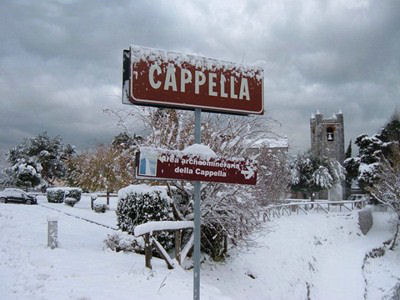What to visit
Azzano
The village of Azzano was born of an ancient Roman settlement at the end of the bloody war that the Romans fought between those mountains, with the tribes of the Ligurian-Lombard period Apuani.In was a fief of the nobles of Corvaia and belonged to the Municipality for a long period of Chapel, the latter developed around the church of St. Martin's Chapel, built in the era unknown a short distance from the village of Azzano. Despite the proximity of the Parish of St. Martin, in the village of Azzano there were two speakers, one dedicated to St. Rocco (in 1579 it is still working) and one still in existence dedicated to St. Michael the Archangel.
The old Town of Chapel
The Town of Chapel , unlike most municipalities around native medieval castles or fortified villages , was built around the church of St. Martin, then elevated to parish church , which also represented the only building of the resort, so this Municipality medieval we can define as a union of scattered hamlets belonging to the curia of St. Martin 's Chapel . The first news that ensure the existence of the Commune Chapel , we find them in a document signed in 1244 , between Major Pennant Montemagno (nobles of Corvaia ) and Bernardino Bozzano ( noble Aghinolfi ) .
The municipality consists of the villages of Azzano , Evolved , Curiceta (disappearance ) , Fabiano , and Giustagnana Minazzana , occupying a large air and initially belonged to the lineage of noble Corvaia , then with the fall of the castle of Corvaia , the Lucchese took possession and in 1413 during the rule of Paul Guinigi, joined him in Pietrasanta , one of the two Vicarie Versilia Lucca , but in 1434 the Lucchese not able to repay a loan at Genoa , were forced to pledge the Ligurian Pietrasanta , giving special privileges to the City of Capella , hoping to keep them friends, which did not happen in 1484 men of the City voluntarily gave themselves to the Florentines in 1776 and Leopold I issued a decree finally joined him in Seravezza .
The Monte Altissimo
The Monte Altissimo is a mountainous belonging to the Apuan Alps. Dominates the high Versilia, Viareggio at Massa, is part of the Regional Park of the Apuan Alps and is recognized as a Site of Community Interest and places of environmental interest within the EEC.
Consisting predominantly of precious marble quality is still home to several quarries at its base (the largest on its top), among which the famous Chapel or Falcovaja, first used by Michelangelo Buonarroti since 1517, particularly thanks to its marble candid, "groped to get away from those mountains of the marble for the facade of San Lorenzo in Florence."

